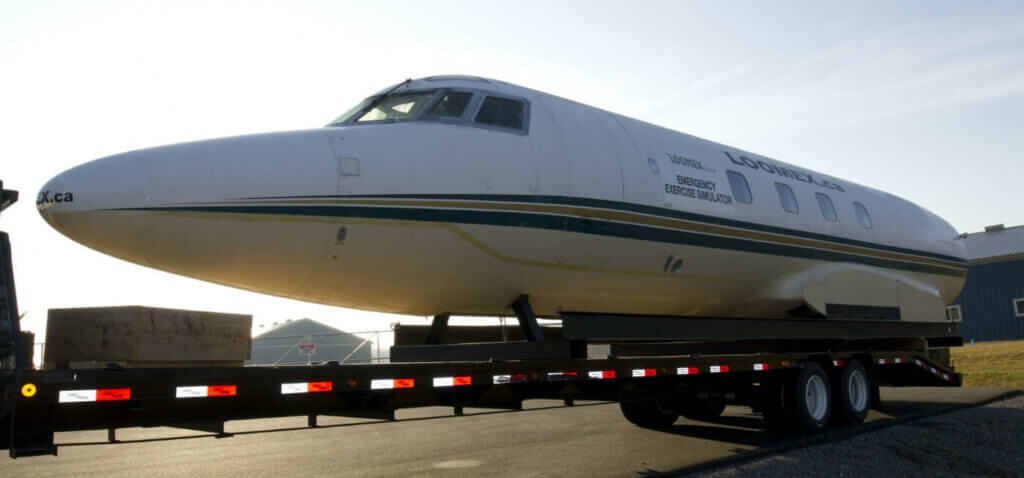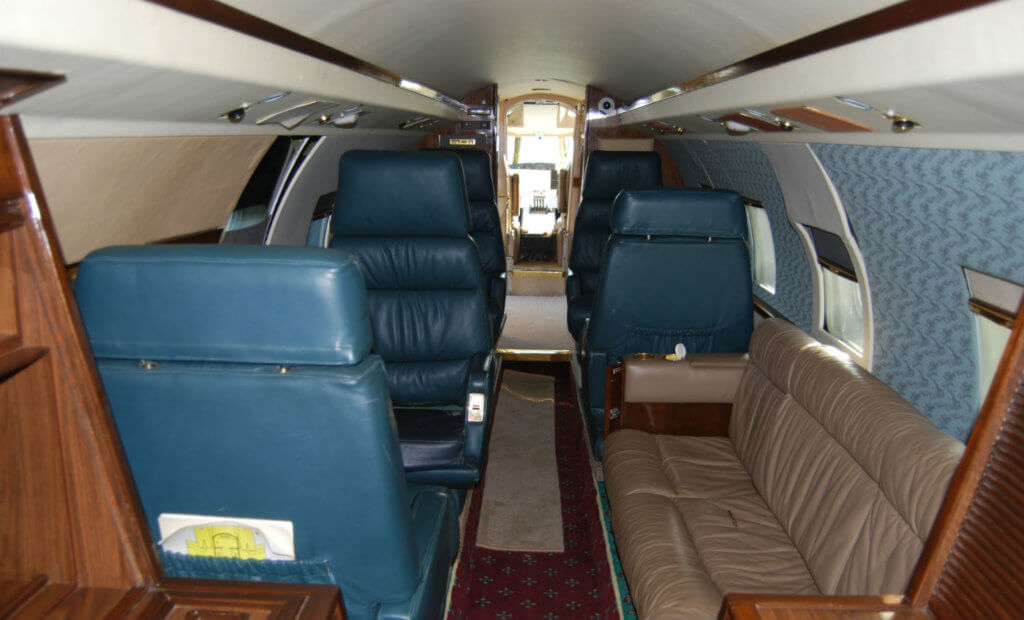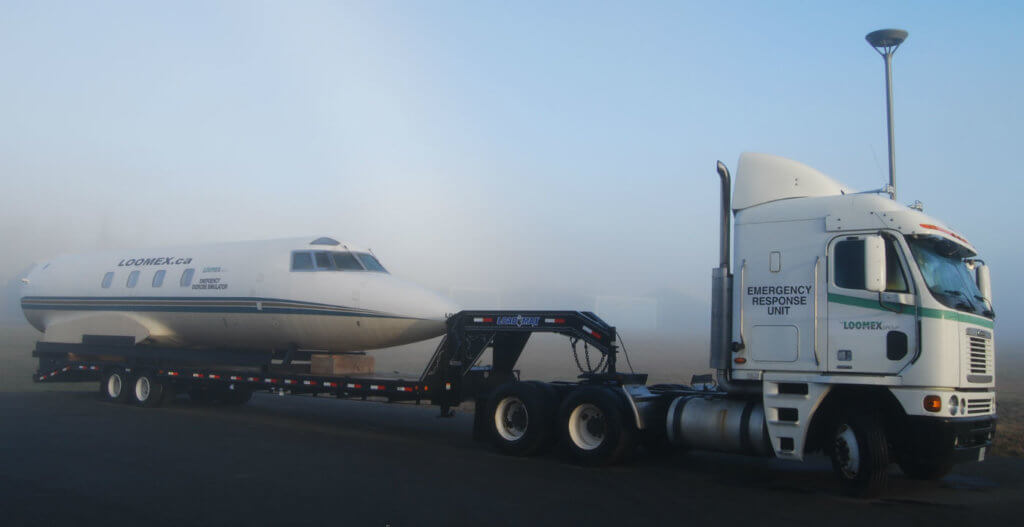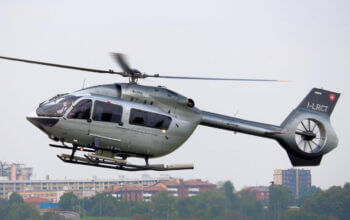Estimated reading time 7 minutes, 38 seconds.
When you operate an airport, accidents will happen sooner or later.
As a 25-year emergency services veteran, Trent Gervais knows this to be true. He also knows that when they do, it’s best to be prepared.
Gervais is CEO of The Loomex Group, based in Peterborough, Ont., which is set to unveil the country’s only portable business jet crash site simulator on Nov. 24. Designed to test emergency response capabilities at airports large and small, the new device was specially constructed from an actual Lockheed JetStar fuselage obtained from neighbouring aircraft services provider Flying Colours Corp.

While The Loomex Group also manages the airports in Peterborough (YPQ) and Kawartha Lakes/Lindsay (CNF4) as well as Seneca College’s Peterborough aviation campus, the company’s emergency training and simulation division represents its fastest-growing business segment.
“We found there is a big hole in the aviation industry with regards to emergency management,” Gervais told Skies. A former fire chief who had responsibility for YPQ, he is passionate about helping smaller airports to be as prepared for emergencies as their larger counterparts.
When The Loomex Group was founded four years ago, its six employees built a smaller simulator to replicate a single-engine aircraft crash. It worked well, especially compared to the previous practice of bringing in a school bus to simulate a crashed aircraft.
Today, the company’s 28 employees are excited to reveal the new business jet simulator.
“For the bigger exercises, I wanted something to make it as real as possible,” said Gervais. “So we started this project to create a simulator that we can take anywhere. The interior is finished as a private jet and we put a cradle on the bottom of the jet, so we can move it with a forklift. We can put it in a field, level or at an angle; there are smoke machines to pump smoke into the cabin; we have sound effects. When responders are coming in, it’s pitch black.”

The project took two and a half years to complete. Gervais said it has now been tested in the field three times, including at a large-scale emergency exercise at Billy Bishop Toronto City Airport that involved 100 responders and 40 actors.
Portable and versatile
Transport Canada requires every airport to complete an annual “tabletop” test of their emergency response plan. Every fourth year, they must hold a large-scale exercise to test first responders and emergency personnel. [Full-scale drills must be held at large airports every two years.]
Gervais said his portable simulator was built with this in mind.
“It’s very versatile and designed to be taken into any airport,” he continued. “EMS, the paramedics, they say they never dreamed how hard it would be to get a pilot or co-pilot out of the aircraft. [Also,] when we’re using actors, we try to use actual pilots when we can. Again, it’s that realism.”
The Loomex Group is planning a coast to coast trip with its new simulator in 2017. In the spring the team will swing through Northern Ontario, with visits to Sault Ste. Marie, Dryden, Geraldton and Red Lake. To keep costs down for everyone, The Loomex Group tries to book concurrent training at local hospitals and municipalities, where they teach courses in human factors, emergency management and crisis communications.
Airports have three options, explained Gervais: They can rent the crash simulator for their own training; hire The Loomex Group to oversee a smaller, limited-scope scenario; or select a complete exercise ranging in cost from $8,000 to $25,000 (for a medium-sized airport). A basic paper tabletop exercise can be created for as little as $5,000.
“There are a lot of airports out there that don’t have a lot of money,” said Gervais. “So, I want to make sure we’re offering them an affordable way to achieve their exercises.”
Following its full-scale emergency management exercise, the company provides airports with a “hot wash” debriefing to discuss what worked well and where improvement is needed. Clients also receive an after-action report that recaps the exercise and provides a training plan for the next one to three years, as well as highlighting the top action items. The simulator is equipped with cameras both inside and out, so clients also receive an exercise video.
“Airport feedback has been really positive,” noted Gervais. “Responders say it’s realistic. We set the exercise up in isolation and don’t tell them what is going on. So when they pull up, they can feel their adrenaline pumping. That’s exactly what I wanted to happen.”
Gervais and his team put a heavy emphasis on realism. The simulator, which travels on a tractor trailer, is accompanied by two more vehicles carrying a portable command centre, props and supplies.

“We lay out a crash site–clothes, shoes, luggage, you name it–when they pull up, it’s as close as we can get it to the real thing.”
A large-scale exercise takes 40 to 60 hours to write. “It’s like writing a play. We take whoever’s going to be there and we create a scenario,” said Gervais. “We have a standard electronic process we go through; we want to understand their [an airport’s] objectives.”
Gervais did his homework before creating the business jet crash simulator. He found a few mostly homemade sims in the U.S., but has never seen anything close to the complete service package provided by The Loomex Group.
With clients already lined up in Ontario and Alberta, he is looking forward to a busy year.
“I am excited,” he concluded. “We’re making it too easy not to use it. It’s affordable for any airport looking to do an exercise.”








